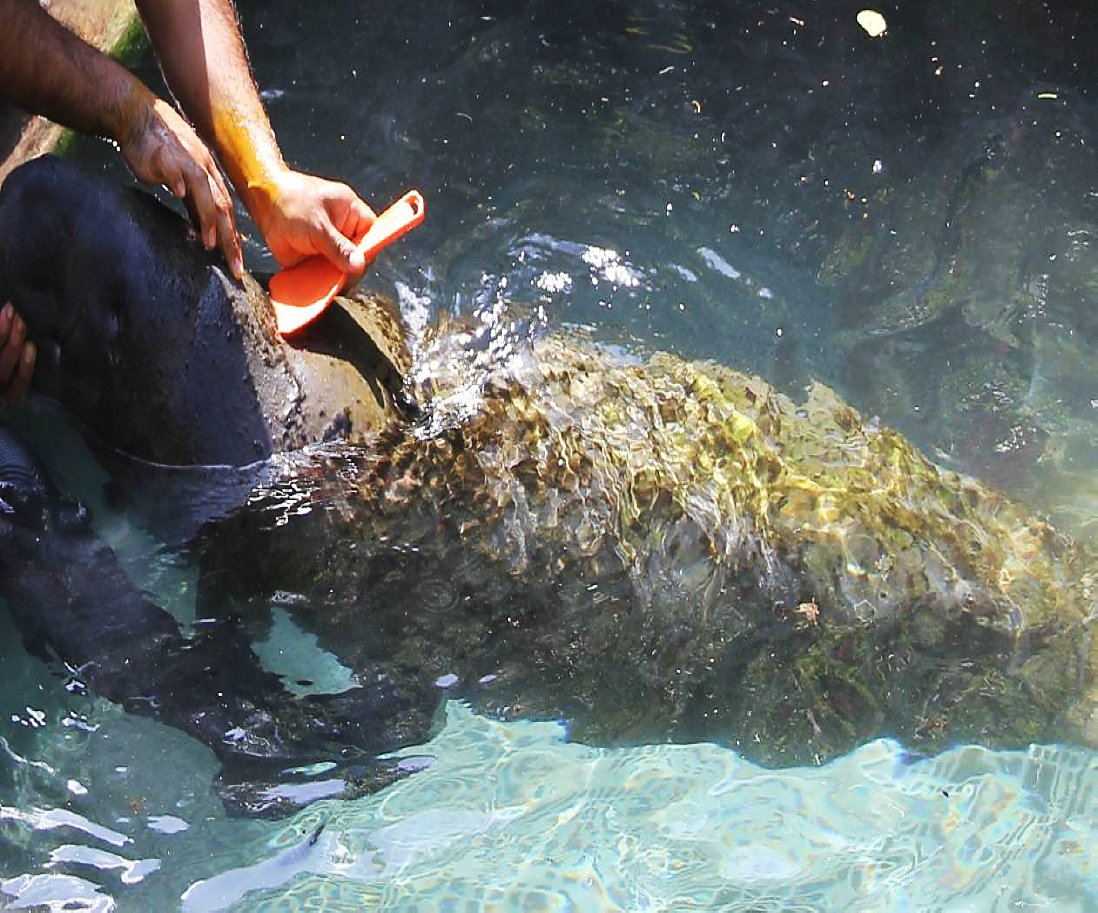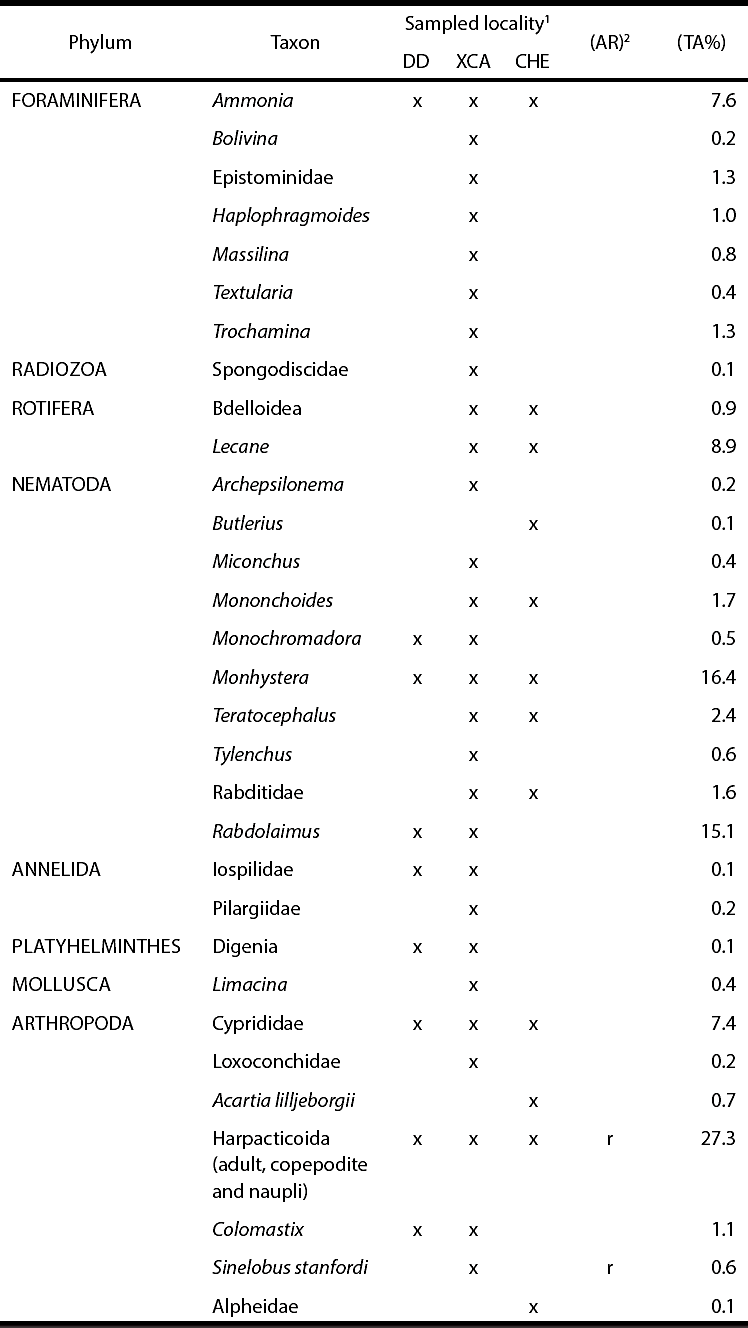INTRODUCTION
The manatee Trichechus manatus Linnaeus, 1758 is a marine mammal endangered of extinction, characterized by a broad distribution area, that inhabits marine, estuarine, and freshwater systems in tropical America, mainly in the Caribbean Sea (Deutsch et al. 2008). In Florida, the manatee subspecies T. m. latirostris Harlan, 1824 has been recognized as a basibiont organism that functions as a wandering ecosystem for various epibiont groups of algae and aquatic invertebrates (Bledsoe et al. 2006; Franckovich et al. 2015), while the Caribbean subspecies T. m. manatus Linnaeus, 1758 has been little studied in this regard (Morales-Vela et al. 2008; Suárez-Morales et al. 2010; Violante-Huerta and Suárez-Morales 2016). Studying epibiont communities in large vertebrates is an indirect method to obtain information on the biogeography, ecology and health of the respective basibiont (Fernández et al. 1998; Liria-Loza 2011). The objective of this investigation is to report new evidence on the diversity of epibiont organisms growing on the skin of the manatee in the Mexican Caribbean.
MATERIALS AND METHODS
In the autumn of 2014, a total of 22 samples were collected from the skin of the back of eleven captive manatees, and salinity (salt) was recorded, in three localities of the Mexican Caribbean Sea: four manatees (two adult females, one adult male and one calf) kept in the marine aquarium (27 ppm salt) Dolphin Discovery Puerto Aventuras (20° 30' 02.13'' N, -87° 13' 32.25'' W), six (three adult females, one adult male and two calves) living in an estuary (18 ppm salt) at Xcaret eco-archaeological park (20° 34' 42.50'' N, -87° 07' 12.91'' W) and one adult male living in the freshwater system (7 ppm salt) at Centro de Atención y Rehabilitación de Mamíferos Acuáticos (Center for Care and Rehabilitation of Aquatic Mammals; CARMA, for its acronym in Spanish), Chetumal Bay (18° 41' 22.19'' N, -88° 15' 47.09'' W). The biological material was collected by scrapping off an area of healthy skin on the back of each manatee with a blunt plastic spatula (Suarez-Morales et al. 2010; Figure 1) covering 100 cm2 (10 x 10 cm quadrants). Immediately afterwards, samples were fixed and preserved in a 8 % formalin solution and placed in labeled vials for analysis in the laboratory. The material was identified to the lowest taxonomic level possible assisted with specialized literature.

Figure 1 Surface scrape technique used for sampling epibionts found on the West Indian manatee in Mexico. Photograph by Raúl Díaz-Gamboa.
The complexity of the epibiont community on the skin of manatees, the lack of information on the physical variables of the substrate (skin), the physicochemical variability of water between localities, and the lack of homogeneity in age and sex of the 11 manatees sampled, were all factors that restrained the conduct of robust statistical studies with the data obtained to establish unequivocal relationships. Consequently, only percent total abundance figures were used.
RESULTS AND DISCUSSION
A total of 1,353 specimens of 31 taxa were found, belonging to eight phyla (Table 1). The dominant taxa were nematodes (39 %), harpacticoid copepods in naupliar and adult stages (27.3 %), foraminifera of the genus Ammonia (7.6 %) and rotifers of the genus Lecane (8.9 %). Large amounts of microalgae directly interacting were also observed (i. e., pennate diatoms) that were neither identified nor quantified.
Table 1 Composition of the epibiont community associated with the skin of the West Indian manatee in the Mexican Caribbean. Association record (AR)2. Total abundance% (TA%).

1 DD= Dolphin Discovery Puerto Aventuras, XCA = Xcaret, CHE = (CARMA) Chetumal bay, x = Presence, 2r = epibiont interaction previously reported.
The interactions of epibiont crustaceans such as harpacticoid and tanaid copepods have been examined in free-living manatees and are recognized as harmless to the health of the specimens studied despite its prevalence and high abundance. The presence of these crustaceans has not been associated with injured skin that could suggest a parasitic interaction (Morales-Vela et al. 2008; Suárez-Morales et al. 2010). At present, there are three species of harpacticoid copepods (Huys 2016; Violante-Huerta and Suárez-Morales 2016) and two species of tanaid copepods (Bonde 2005; Morales-Vela et al. 2008; Ortiz et al. 2010) that have been reported as well-established manatee epibionts. In addition to the presence of unidentified harpacticoid copepods and the previously recorded tanaid Sinelobus stan-fordi, the present study includes five groups of crustaceans that had not been previously found as manatee epibionts: Cryprididae, Loxoconchidae, Acartia lilljeborgii, Colomastix and Alpheidae. These groups were unrelated to skin injuries in the manatee individuals sampled.
The species Acartia lilljeborgii is considered a strictly planktonic species (Campos and Suárez-Morales 1994); hence, its presence on manatee skin could be an incidental finding. In addition, groups of microinvertebrates were found on healthy skin that had not been previously observed as epibionts of manatees in the Caribbean: foraminiferans (n = 7), radiolarians (n = 1), rotifers (n = 2), nematodes (n = 10, dominant), annelids (n = 2), mollusks (n = 1), and platyhelminthes (n = 1). The findings in this study deepen our knowledge about the external interactions in sirenians, since 29 of the 31 taxa observed in this work are new records of epibionts for the subspecies T. m. manatus and for the order Sirenia around the world.
The difference between the diversity of taxa observed in this research and previous reports may have been associated with the captivity status of the specimens sampled. This is due to the hydrologically more stable environments, which facilitate the establishment of colonizing organisms on the available substrate (Railkin 2004). In addition, captivity reduces the exposure of individuals to fluctuations in water salinity and temperature - the primary variables that influence the known load of epibionts in free-living manatees (Bledsoe et al. 2006). In addition, captivity favors the retention of nutrients, suspended detritus, bacteria and microflora, which ultimately become part of the biofilm that develops on the skin of manatees. These are likely utilized as food sources for the opportunistic microfauna reported, a common behavior for epibiont organisms (Humes 1964; Bledsoe et al. 2006).
Given the complexity associated with the study of epibiont communities and the richness of species associated with the skin of captive and free-living manatees, it is essential to record hydrological variables, assess the influence of the immune status of the manatee (Halvorsen and Keith 2008), correlate the physical composition of the skin (Wahl and Mark 1999; Wahl and Hopper 2002), and analyze the parasitizing potential of opportunistic species, to better understand the ecological niche of manatees as a wandering substrate in the western Caribbean.











 text new page (beta)
text new page (beta)


